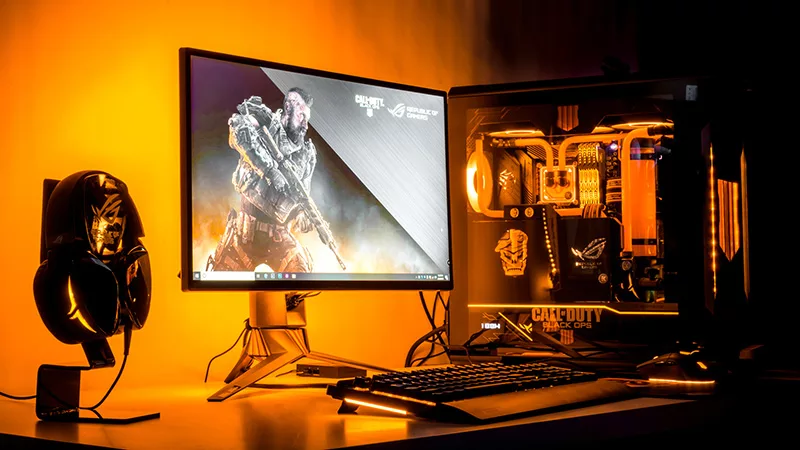Built for esports: Introducing the ROG Strix GL12 gaming desktop
Competitive esports events showcase gaming at the highest level for throngs of eager fans. Pros need powerful PCs that maintain maximum FPS through the heat of battle, tournaments require reliable systems that let players quickly load their own settings, and amateurs desire customizable rigs that can grow with their rank. The new ROG Strix GL12CM gaming desktop satisfies them all with overclocked hardware, a hot-swap SSD bay, and a stealthy design punctuated by Aura Sync RGB lighting. It will be on display at CES 2018 in Las Vegas, NV, from January 9-12.

Hot clocked and liquid cooled
High-stakes matches can be decided by split-second reflexes, so esports PCs need to be impeccably responsive to meet the demands of professionals. The Strix GL12CM ensures games run at top speed on up to an Intel Core i7-8700K processor that’s factory overclocked to 4.8GHz across six cores and 12 threads. Coffee Lake’s extra cores help sustain smooth frame rates when you’re streaming with software-based encoding or performing other background tasks while you play.
Only the best chips make the grade for the overclocked version of the GL12CM. We test each one at the factory to confirm that it’s comfortable when pushed so far beyond the 4.3GHz stock frequency for all-core loads. Then we add liquid cooling to reduce temperatures and prevent thermally induced slowdowns from hitching your gameplay. The closed-loop CPU cooler is supplied by the experts at Asetek, and it’s the same unit used in the ultra-high-end ROG GT51 desktop.
The GPU is the most important factor for gaming performance, so the Strix GL12CM uses graphics cards from NVIDIA’s latest GeForce 10 series. These cards support G-Sync, which pairs perfectly with the ROG Swift gaming monitors used in major esports tournaments. The flagship GL12CM has a GTX 1080 that pumps out enough FPS to saturate the ultra-high-refresh that pros favor, like the 180Hz ROG Swift PG248Q and 240Hz PG258Q. And all configurations with GTX 1060 or better graphics include dual HDMI outputs that make it easier to connect VR headsets.
An internal crossbar secures the graphics card to guard against damage from the unavoidable knocks and bumps that can happen when systems are shipped across the world for big gaming events or taken across town for local LANs. This reinforcement holds the card level, eliminating the scourge of GPU sag that plagues so many custom gaming desktops.
The graphics card uses a Turbo-style blower that exhausts warm air out the back of the chassis. It’s complemented by a smart internal layout that supports up to three internal fans. Cool air enters the chassis through a 120-mm intake up front. It flows into the lower chamber, which houses the storage bays, and into the main compartment with everything else. Liquid-cooled versions of the Strix GL12CM affix their radiators to a 120-mm exhaust in the top of the chassis, and there’s room for a 90-mm fan in the back.

A striking design that slashes volume
Although the Strix GL12CM hits like a heavyweight, it moves like a middleweight. The 27-liter chassis is noticeably narrower and more compact than typical gaming PCs, making it easier to transport and fit wherever you need to play. A blacked-out aesthetic lets the GL12CM blend into the shadows if you want to keep a low profile, but slashes across the front also let RGB lighting bleed through. Colors and effects can be configured independently for each cut and the ROG logo using our Aegis III system utility. The lighting can also be set to match the glow of Aura Sync-compatible peripherals like ROG gaming keyboards and mice to give your battlestation synchronized illumination.
To meet EMI regulations, the GL12CM ships with a solid metal side panel that blocks electromagnetic interference--but also your view of what’s inside. We know you want a peek, so an acrylic replacement is included in the box. Both panels are secured with thumb screws, which makes swapping them a trivial task with no tools required.
The window panel stretches across the entire side of the chassis like a piece of tempered glass. We opted for acrylic because it’s durable, with strong scratch resistance and less chance of damage from an accidental drop or other physical shock. Despite this resilience, acrylic is also lighter than tempered glass, providing a great view without excess weight.
Hot to swap
The front face is covered by a removable magnetic panel modeled after a ninja’s mask. Popping it off reveals the hot-swap SSD bay, a special addition for the esports event organizers who use our desktops for their tournament machines. Games and player settings are typically stored on 2.5” SSDs that need to be swapped quickly when prepping for a match. The hot-swap bay lets secondary storage drives slide in and out in seconds, without tools or rebooting, making it perfect for busy tournament environments. Rebooting is required if you want to swap the drive holding your operating system, though.
We initially tried putting the hot-swap bay at the top of the chassis, but it occupied a lot of space, and we wanted to make the case more compact. Switching to a front-loading bay allowed us to shrink the chassis without sacrificing usability or practicality. In addition to being handy a must-have for esports tournaments, the hot swap bay makes it ridiculously easy for anyone to add another storage drive to the Strix GL12CM.

Fully connected with room to grow
A custom-built microATX motherboard provides the foundation for the GL12CM. It’s black to match the rest of the stealthy motif, and the form factor strikes a good balance between compact dimensions and sufficient expansion. There are four DIMM slots with support for up to 64GB of overclocked DDR4-2800 memory, plus a quad-lane M.2 slot that supports NVMe SSDs and Optane caching. The chassis adds its own internal storage cage with dual bays that can hold 2.5” or 3.5” drives, plus one that’s 2.5”-only. Pre-installed storage configurations will vary by model, but all versions provide multiple options for upgrades.
Around back, you get enough USB ports for a keyboard, mouse, VR trackers, and multiple controllers. Two of the rear ports support 10Gbps USB 3.1 Gen 2 speeds for high-speed external storage and next-gen devices. There are four USB ports up front, which is handy for quickly grabbing files from thumb drives, plus an embedded card reader that makes it easy to grab images and footage from DSLR cameras. The integrated networking covers all the right bases, with optional 802.11ac WiFi for wireless convenience and a reliable Intel Gigabit Ethernet controller for serious multiplayer action over a wired connection.
Audio is piped through an ALC1150 codec paired with premium Nichicon capacitors that help produce a warmer, more natural sound. The integrated solution has a 115-dB SNR, and it’s backed by our Sonic Studio and Sonic Radar software. Sonic Studio III helps teammates and viewers hear you more clearly by filtering noise, reducing artifacts, and stabilizing input volume. Sonic Radar III maps positional audio on a visual 3D overlay that lets you see the origin of sounds, a handy tool for the hearing-impaired or gaining a cheeky advantage over your opponents.
Built for esports but fit for everyone
The Echo Fox LCS team has already committed to using the Strix GL12CM, but the latest ROG gaming desktop isn’t just for esports pros. Its powerful hardware, good looks, and upgrade-friendly design are ideal for a wide variety of gamers, from regular players to amateur competitors to streaming stars. Expect the GL12CM to arrive later this year; check with your local ROG representative for more details on the availability and pricing for the configurations destined for your region.
We announced loads of new ROG gear at CES 2018. To read about all of the newest toys coming to the Republic of Gamers, head on over to this article.


